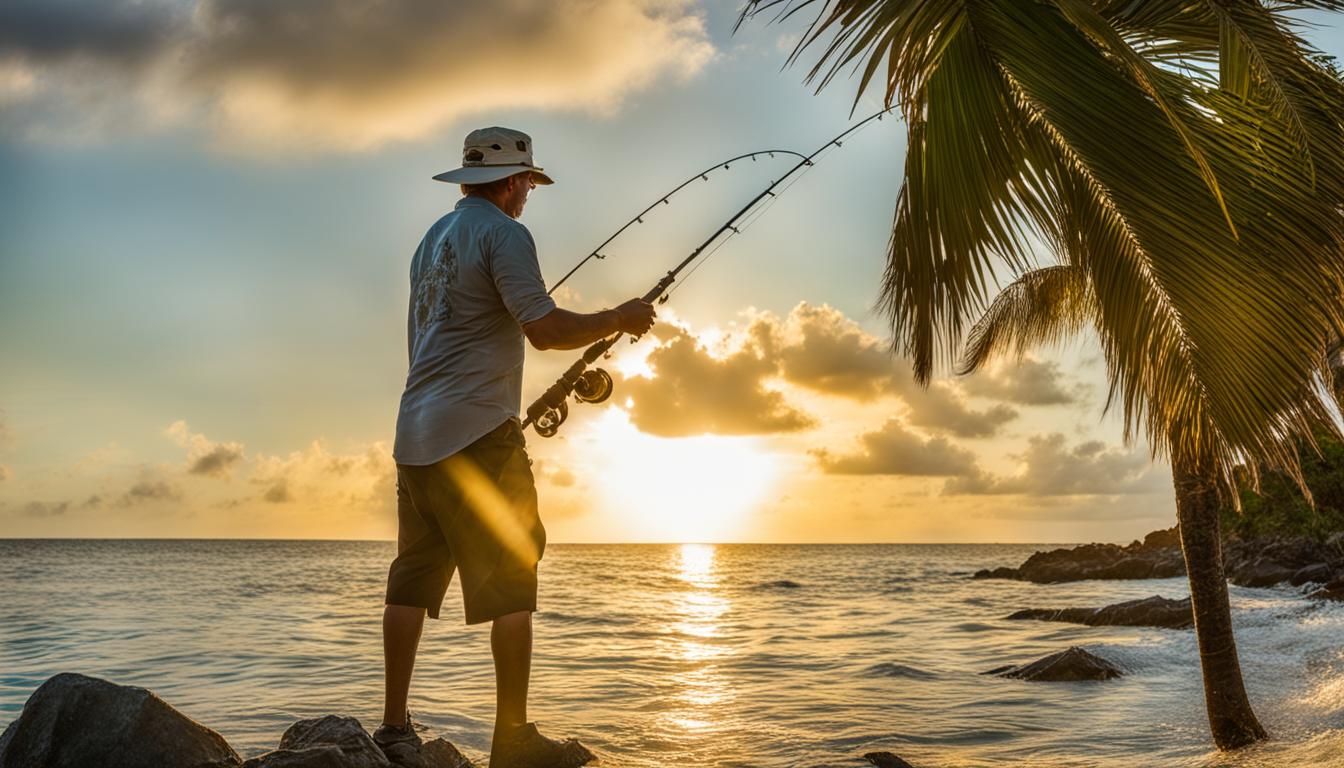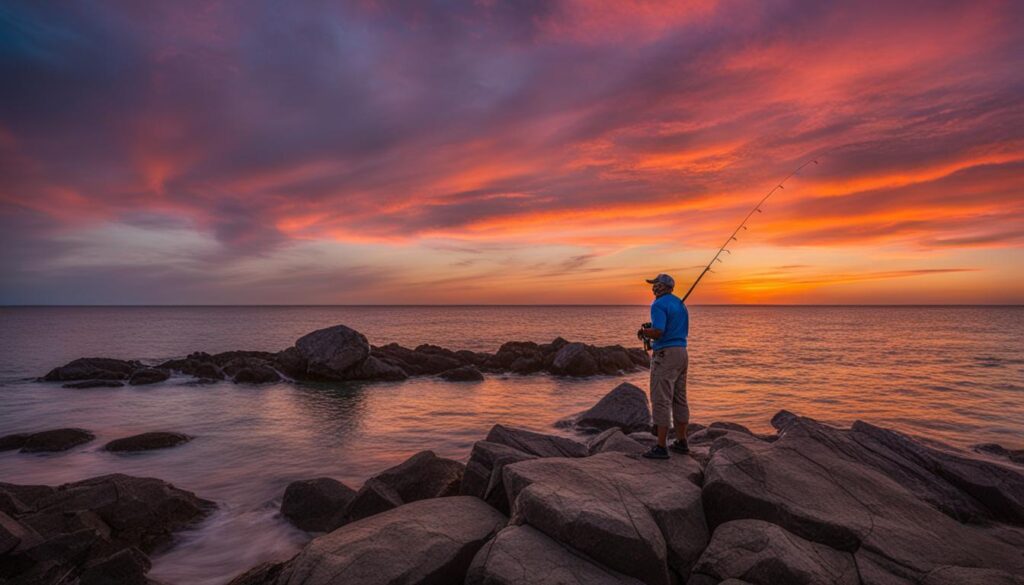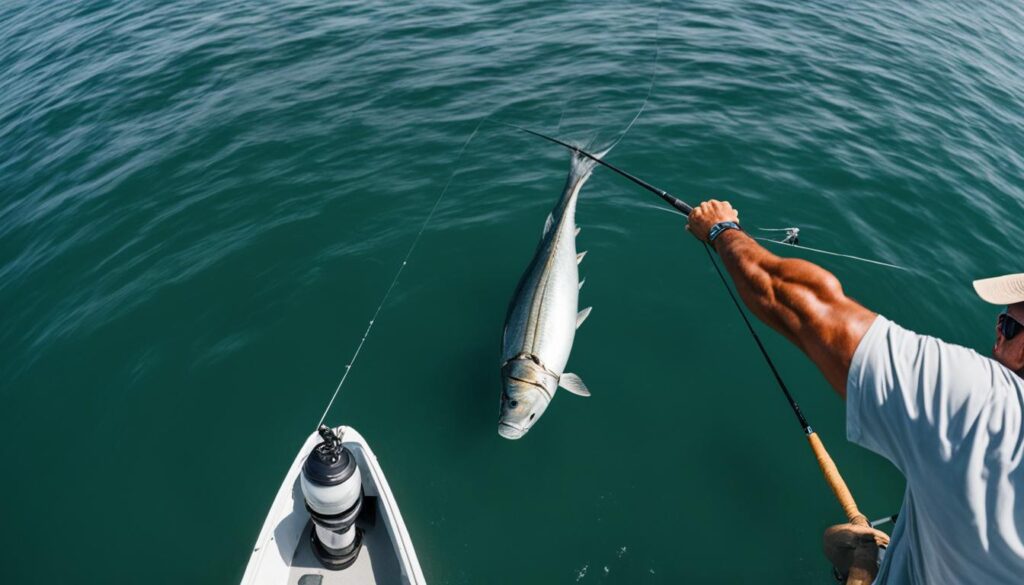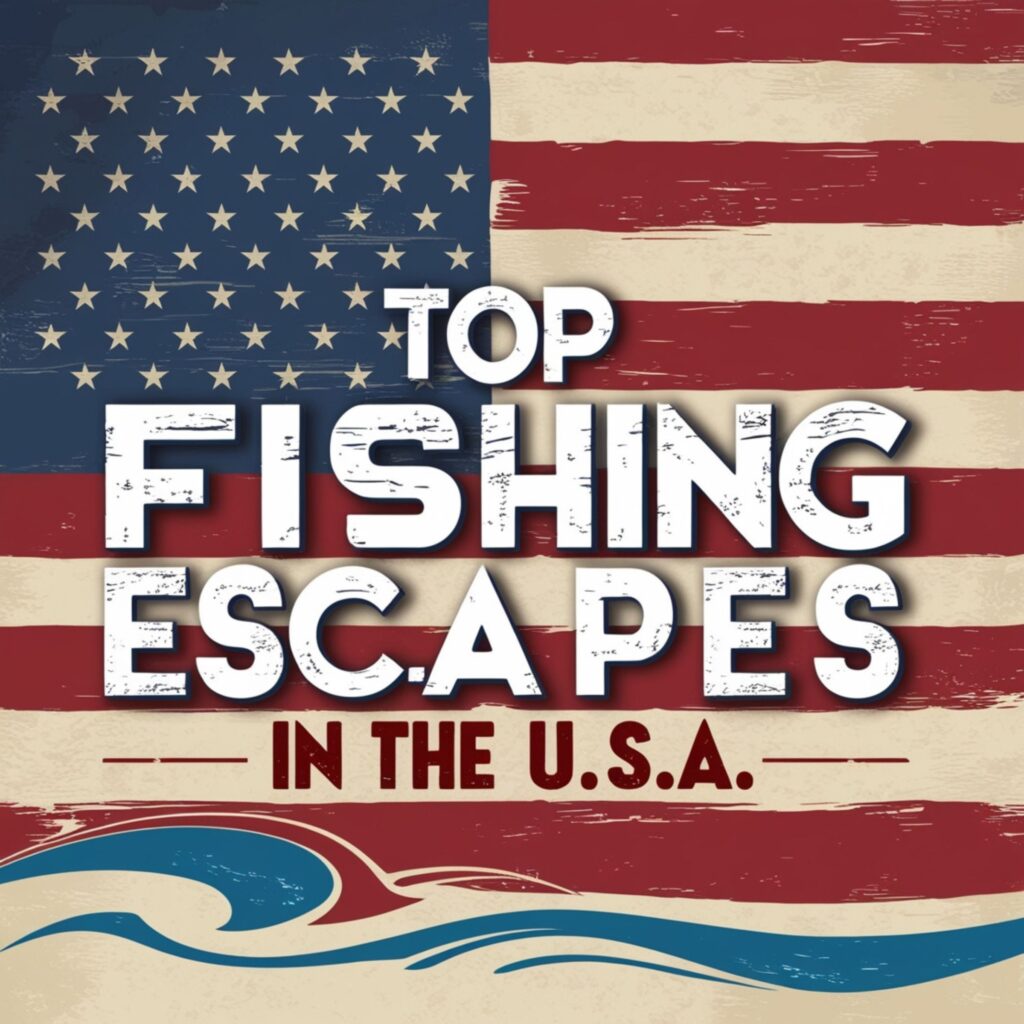
Top Shoreline Tarpon Angling Tips for 2024
On January 16, 2024 by fishingamericatoday StandardCapturing the elusive Silver King from the shores of Florida is an experience like no other, and with the right shoreline tarpon angling tips, you’re set to make 2024 your most triumphant fishing year yet. Whether you’re a seasoned angler or dipping your toes into the world of tarpon fishing techniques, the thrill of engaging with one of fishing’s greatest adversaries awaits.
Florida’s balmy waters offer a perfect arena for tarpon, providing anglers with opportunities to test their tarpon angling strategies against these acrobatic giants. But success isn’t just about chance; it requires finesse, patience, and understanding of the fish’s patterns and habitat wishes. Let’s dive into the realm of Florida tarpon fishing and unfold the secrets to transforming your angling game along the picturesque Florida coastline.
Understanding the Silver King: Tarpon Characteristics and Behavior
Unlock the mysteries surrounding the majestic Tarpon, a prized catch for anglers engaged in Florida tarpon fishing. These prehistoric fish are not only prized for their size but also for their energetic fight, making fishing for tarpon a true angler’s quest. By delving into their unique traits and behaviors, you’ll be better prepared with the tarpon fishing tips and tricks needed to land these spectacular fish.
Impressive Population and Growth Patterns
Florida’s waters serve as a thriving habitat for Megalops atlanticus, where they boast remarkable growth patterns. Adult tarpon frequenting these parts often stretch to impressive lengths of five to six feet, tipping the scales at a solid 100 to 150 pounds. With lifespans that can surpass half a century, these formidable creatures present anglers with countless opportunities for an unforgettable catch.
Notorious Acrobatics and Fight Techniques
It’s the tarpon’s aerial prowess and strength that earn it the moniker “Silver King”. Experienced tarpon anglers will attest to their notorious acrobatics, capable of leaping up to ten feet above the surface, providing an exhilarating challenge to even the most seasoned fisher. Their robust fight techniques warrant a strategic approach to each phase of the battle.
Preferred Habitats and Water Temperatures
Understanding the tarpon’s preferred environments is crucial for planning your fishing adventures. These fish gravitate towards warm, shallow saltwater territories – flats, canals, bays, and brackish waters serving as their favored arenas. Taking advantage of Florida’s tropical and subtropical waters, tarpon show distinct preferences for spots that boast temperatures between 74–88ºF, aligning perfectly with the Sunshine State’s inviting coastline.
Shoreline Tarpon Angling Tips

Discover the thrill of tarpon fishing inshore with expert tactics and insightful shoreline tarpon angling tips. Timing your pursuits to align with the tarpon’s feeding habits can make a significant difference in your fishing success. Aim for the early morning or late afternoon, when these majestic fish are most active.
Live bait such as mullet, pinfish, and crabs are irresistible to tarpon, enticing them closer to your line. But it’s not just what you use as bait, it’s how you present it. Below, you’ll find a handy table listing recommended approaches and respective bait types to boost your chances of reeling in the notorious Silver King.
| Bait Type | Approach | Additional Hacks |
|---|---|---|
| Live Mullet | Drift Fishing | Use a float to keep bait at surface level |
| Pinfish | Bottom Fishing | Trim the tail to create a distress signal |
| Crabs | Float Rigging | Add weight for stability in strong currents |
| Artificial Lures | Slow Retrieval | Use lures that mimic natural prey movements |
Stealth is your ally when approaching tarpon. Use quiet electric motors or consider poling to get close without startling them. And when the explosive action happens—as it often does with tarpon—remember to ‘bow to the king.’ This means lowering your rod tip when the fish leaps to ease tension on the line, helping prevent a break-off and protecting your gear.
By employing these tarpon fishing hacks and respecting the tarpon’s environment, you’ll not only enjoy the rush of the fight but contribute to the sustainability of the sport. Get ready to set out on the water and create memories with every cast!
Strategic Fishing for Tarpon: Live Bait vs. Artificial Lures
When it comes to successful tarpon fishing techniques, the debate between using live bait and artificial lures is ongoing. Understanding the dynamics of each method can be the difference between a productive day on the water and coming home empty-handed. Let’s dive into the best strategies for leveraging each type of bait.
Natural and Live Bait Techniques
Utilizing natural and live bait effectively requires a combination of timing and presentation. During the ebb tide, natural baits such as shrimp and crabs yield the best results through up-current drifting techniques. Presenting these baits at the right depth and location is crucial, as tarpon are known for their keen instincts. The use of live baits, like pilchards, mullet, and pinfish, demands they be hooked in a manner that promotes both longevity and natural movement—keys to attracting tarpon.
Artificial Lures for Inshore Tarpon
Conversely, artificial lures provide a different type of challenge in tarpon angling strategies. When using lures, replicating the subtle movements of live bait can prove effective, particularly when performed with a slow and deliberate retrieve. The nuanced action of lures like soft plastics or suspending plugs can intrigue and entice a tarpon, provided they are worked in a manner that acknowledges the tarpon’s acute awareness and preference for live prey.
Choosing the Right Tackle and Gear
Equally important in tarpon fishing gear selection is the tackle setup. Heavy-action rods paired with appropriate reels are recommended to handle the impressive strength of these large fish. As for line and hooks, durability and sharpness are paramount. Choosing the right combination of rod, reel, line, and hook size is instrumental to not only hooking but also successfully fighting a tarpon.
- Gear Setup: Heavy-action rods, 50-80 lb test line, and size 3/0 to 7/0 hooks.
- Bait Presentation: Keep live bait swimming naturally; mimic live bait movement with lures.
- Fishing Strategy: Up-current drifting with natural baits; slow retrieves with artificial lures.
Remember, tarpon fishing isn’t just about the catch—it’s respecting the sport and the species. By choosing the right gear and employing thoughtful techniques, you’ll enhance your tarpon fishing experience and contribute to sustainable fishing practices.
Prime Time and Spots for Florida Tarpon Fishing
When you’re planning your next fishing adventure, timing and location are everything, especially for tarpon fishing in Florida. Technically known as the Silver King, tarpon offer one of the most thrilling experiences on the water, and knowing the best time to go tarpon fishing in Florida is key to securing a prize-worthy catch.
Peak Seasons for Landing the Silver King
The major tarpon migrations bring these giants close to shore, creating the perfect opportunity for anglers. Seasons differ slightly depending on which coast you’re planning to fish from:
- Gulf Coast: Peak season runs from May to July, where warm waters draw in large schools of migratory tarpon.
- Atlantic Coast: April through June sees tarpon flocking to the warmer waters along the eastern shoreline.
Aligning your fishing trips with these periods increases your chances of encountering tarpon, as these seasons coincide with their natural migratory patterns in pursuit of ideal spawning conditions.
Best Fishing Locations in Florida for Tarpon
Florida is replete with renowned hotspots for pursuing the acrobatic Silver King. From backcountry to offshore, each location presents unique challenges and opportunities:
| Location | Best Timeframe | Notable Features |
|---|---|---|
| Florida Keys | Late May – October | Famed for its crystal-clear waters and long fishing season. |
| Boca Grande Pass | May – July | Known as the ‘tarpon capital of the world’ with high catch rates. |
| Everglades National Park | Spring – Early Summer | Offers a mix of serene backcountry waters and challenging angling. |
| Homosassa Bay & Crystal River | May – June | Quiet coastal waters are perfect for sight fishing and fly anglers. |
| Seven Mile Bridge & Bahia Honda Bridge | April – June | Bridge channels that are natural migratory paths for tarpon. |
Whether you choose the legendary waters of the Boca Grande Pass or the picturesque flats of the Everglades, Florida unmistakably offers some of the top tarpon fishing spots for every angler. Remember to monitor water temperatures and baitfish movements for the best outcomes—tarpon thrive in warm waters that attract plenty of prey.
Mastering the Hook and Fight: Tarpon Fishing Techniques

When seeking the thrill of catch-and-release battles with the mighty tarpon, understanding how to fish for tarpon efficiently is crucial. Delving into the specifics of hook setting and fight techniques will greatly increase the odds of not just hooking, but also responsibly landing these majestic fish.
Proven Hook Setting Strategies
Setting the hook in tarpon involves a blend of patience and precision. When fishing with natural bait, it’s paramount to sense the fish’s weight against the line before executing a firm strike. This increases your chances of securely hooking a tarpon. Furthermore, when you’re employing lures, adapt your timing: quick strikes are necessary for rigid lures, while a more delayed reaction can be beneficial when using flies.
Techniques for Fighting and Landing Tarpon
The battle that ensues post-hook is filled with spectacular jumps and intense runs from the tarpon. Remember to execute the ‘bow to the king’ during its leaps to prevent line snap. This technique involves lowering your rod tip and giving slack to absorb the shock. When it comes to how to land a tarpon, it is a careful art. Embrace patience, as you’ll need to guide and revive the tarpon before the delicate removal of the hook, emphasizing catch-and-release ethics.
| Action | With Natural Bait | With Hard Lures | With Flies |
|---|---|---|---|
| Strike Timing | Wait for weight of fish | Immediate | Wait for weight of fish |
| Rod Action | Strike firmly, keep tip low | Quick, sharp strike | Deliberate, firm hook set |
| Fight Technique | Bow during leaps, maintain tension, guide carefully | ||
| Landing Process | Revive, careful hook removal, return to water | ||
Responsible Tarpon Angling: Conservation and Regulations
When you’re battling the legendary Silver King, the excitement is incomparable, but it’s imperative to remember that responsible tarpon angling goes beyond the thrill. It extends to the practices that ensure the species thrives for years to come. By adhering strictly to tarpon fishing regulations and employing tarpon angling strategies that emphasize conservation, you play a key role in maintaining the sport’s sustainability and integrity.
Importance of Catch and Release
Catch and release isn’t just a suggested practice; it’s a cornerstone of maintaining healthy tarpon populations. The implementation of catch and release allows these majestic fish to continue their life cycle, which is crucial since tarpons are often caught before they reach reproductive maturity. By using barbless hooks and handling tarpon with care, you ensure minimal harm, boosting survival rates after release. Remember, the way a tarpon is released back into the water can also determine its chance at survival, so always be gentle and patient during this process.
Understanding Tarpon Fishing Regulations
Florida leads as an example in the conservation of tarpon with regulations that anglers must familiarize themselves with. These regulations cover everything from the legal means and methods of catch to the meticulous processes required for weighing. Some critical points include the prohibition of snagging tarpons and the use of multi-hook tackle. To possess or weigh a tarpon, a tag is required, and such activities are highly regulated to discourage the removal of large tarpons from the water. Knowledge of these regulations will not only keep you within the bounds of the law but also contribute to the ethical pursuit of the sport.
Booking Your Tarpon Fishing Adventure: Guide Recommendations and Tips
Setting out on a shoreline tarpon angling expedition is thrilling, and often the secret to success lies in the local expertise that a seasoned guide can provide. Whether you’re new to the world of tarpon fishing or seeking to refine your skills, these professionals present a treasure trove of guide recommendations for tarpon fishing. They bring not only an understanding of the local aquatic terrain but also pinpoint the optimal conditions for a lucrative catch.
By booking your tarpon fishing adventure with a reputable guide, you multiply your chances of experiencing the adrenaline rush of reeling in the mighty Silver King. From the Florida Keys to the serene waters off Jupiter, guides are equipped to show you the ropes, offer valuable insights on tarpon behavior, and teach you the proper techniques of fighting and safely releasing these noble creatures. They prioritize not just the pursuit of the catch, but ensuring the welfare and longevity of the species—imparting a fishing ethic that honors conservation as much as the sport itself.
Commit to a successful and responsible fishing experience by seeking the guidance of those who navigate these waters daily. A captain-guided trip is more than just an outing; it’s an investment in your angling acumen and a commitment to sustaining one of Florida’s most exhilarating fishing opportunities. So, when planning for the highlight of your fishing calendar, consider engaging a gifted guide to lead your tarpon journey–the payoff is an unforgettable adventure steeped in learning and triumph.
FAQ
What are the best shoreline tarpon angling tips for 2024?
To maximize your chances of success, fish during peak feeding times in the early morning and late afternoon. Use live baits like mullet, pinfish, and crabs, or artificial lures that mimic these species, and approach tarpon quietly and stealthily to prevent spooking them. Be prepared to ‘bow to the king’ during their leaps to maintain line tension and prevent breakage.
Can you describe the tarpon’s population and growth patterns?
Tarpons are known for their impressive size and longevity, with adult tarpons usually reaching five to six feet in length and weighing between 100 to 150 pounds. These prehistoric creatures can live up to 50 years in the wild and prefer the warm waters of Florida’s coast, where they have a substantial and thriving population.
Why are tarpon’s acrobatics and fight techniques significant for anglers?
Tarpon are renowned for their acrobatic behaviors, including high leaps when hooked, which add to the challenge and excitement of fishing for them. Their fight techniques, such as powerful runs and frequent jumps, require anglers to use specific strategies to successfully hook, fight, and land these strong and energetic fish.
What water temperatures and habitats do tarpons prefer?
Tarpons thrive in warm waters within the 74–88ºF range, typically found in shallow saltwater environments like flats, canals, bays, and brackish waters. Their migration patterns seek out warm tropical and subtropical waters, which are abundant along the Florida coastline.
How does the choice between live bait and artificial lures affect my tarpon fishing strategy?
Live bait tends to entice tarpon naturally, especially when used with up-current drifting techniques during the ebb tide. Artificial lures can be equally effective when they mimic the movements and appearance of tarpon prey. Your choice affects the fishing technique and the type of tackle to be used, so it should align with your comfort level and the tarpon’s behavior at the time.
What tackle and gear are needed for tarpon fishing?
You’ll need heavy-action rods and strong lines to withstand the tarpon’s vigorous fight. Various hook sizes are recommended to match the tarpon’s large size and bony mouth. Sharp hooks are critical for a secure hookset. Additionally, it’s important to have the proper rigging and tackle to handle the specific lures or bait you plan to use.
When is the best time to go tarpon fishing in Florida?
The optimal window for tarpon fishing in Florida typically spans from May to July on the Gulf Coast and April through June on the Atlantic Coast. These periods align with the tarpon migrations and offer the highest probability of engaging with these majestic fish.
Where are the top tarpon fishing spots in Florida?
Hotspots for tarpon fishing in Florida include the Florida Keys, Boca Grande Pass, and the east/central Florida beaches. Notable locations within these regions are the Channel Bridges, Tom’s Harbor, Seven Mile Bridge, Long Key, Bahia Honda Bridge, Homosassa Bay, the Crystal River, and Everglades National Park.
What techniques should I use for setting the hook and fighting tarpon?
Use natural bait techniques like waiting to feel the weight of the fish before striking for a successful hookset. When fighting tarpon, keep the rod tip low and perform a ‘bow’ to the fish during its leaps to reduce the chance of line breakage and to maintain tension.
Why is catch and release important in tarpon fishing?
Catch and release is crucial for conserving the tarpon population, ensuring their survival post-catch, and maintaining the sport’s sustainability. Use barbless hooks and handle tarpon gently, particularly large ones, which should not be removed from the water. Applying proper release methods can greatly enhance the survival rates of released tarpon.
What should I know about tarpon fishing regulations in Florida?
It’s essential to familiarize yourself with Florida’s tarpon fishing regulations, which include gear restrictions, fishing licenses, and catch-and-release requirements designed to preserve tarpon populations. Adhering to these regulations is both legally necessary and an integral part of responsible fishing practices.
How can booking a guided tarpon fishing adventure enhance my experience?
Booking a guided tarpon fishing adventure with an experienced captain can increase your chances of a successful catch, provide local knowledge, peak season timing, and proven fishing techniques. Guides also teach proper fighting and release methods, ensuring a memorable and ethical fishing experience.
Source Links
- https://captainexperiences.com/blog/the-complete-guide-to-tarpon-fishing
- https://www.floridasportsman.com/editorial/beach-fishing-for-tarpon/396427
- https://fishingbooker.com/blog/tarpon-fishing-in-florida/
